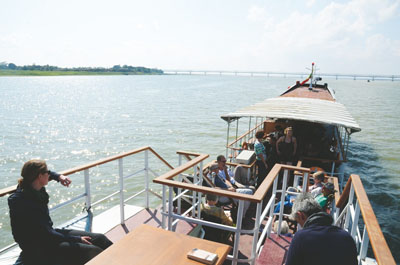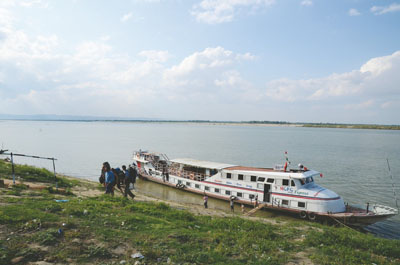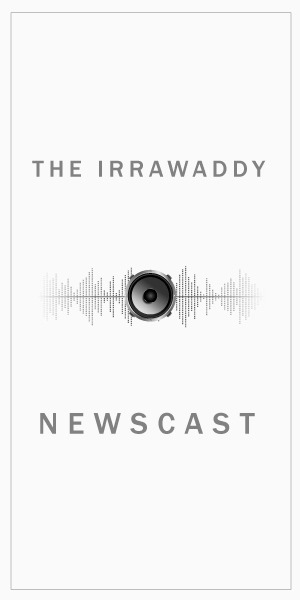BAGAN — As the morning light hits the bow of the boat, I huddle in my seat, swaddled in scarves and towels. Underneath this bundle of fabric I am wearing a hat, three t-shirts, a sweater and a jacket, and leggings under jeans. It is the hot season in Myanmar, but it is cold, so utterly and bitterly cold that beyond the bag-lady getup, I have been driven to that most grievous of crimes: socks under sandals.
This wasn’t exactly expected. My parents and I had set off on what we anticipated would be a luxurious 10-hour cruise south down the Ayeyarwady River from Mandalay to the ancient temple city of Bagan. With visions of lying on deck reading my book under a tropical sun, I had packed sun block, a bikini and sunglasses.
But a freak storm blew in from the Indian Ocean overnight, and we drove out of the Shan Hills into Mandalay in a howling gale. Our boat, the Myanmar Golden River Group (MGRG) Express, left the jetty in the early morning, and the 7 am start was wet, cold and gray; as the boat set off it got increasingly wetter, colder and grayer—until everyone sitting up on deck was shivering under layers of sweaters.
The boat was one of a number that ply the busy currents of the Ayeyarwady, ferrying tourists and locals daily between Mandalay, Bagan and smaller towns.
For those seeking a more adventurous journey, the government “slow” boat is the local option, taking villagers, merchants and their goods to towns along the riverbank. This is notoriously unreliable and can take anything from 15 hours upwards—but can give a vibrant and rewarding taste of Myanmar life for those willing to forgo Western comforts.
At the extreme other end of the spectrum, those prepared to pay can spend days aboard luxury river cruise ships such as those owned by Orient Express, which boast swimming pools and spas. We pass a couple of these boats—hulking double-decked expanses of polished teak, replete with uniformed staff. It was a magnificent and somewhat colonial sight—but notably empty, with only a smattering of tourists knocking about the vast decks.

Our vessel lies in the mid-range, one of the so-called “express boats” that charge a premium of around US$50 for the 10-hour journey between Mandalay and Bagan. We chose MGRG Express, but most, according to our hotel owner, are very similar—another major company is Malikha River Cruises.
Despite the price, it is a basic set up: Two meals are included (egg for breakfast, rice for lunch), but the boat stocks no other snacks for the long journey and by the end, even the soft drinks run out. Rattan easy chairs face out towards the river, under a tarpaulin awning to protect from (eventual!) sun. A raised deck at the stern caters to sun worshippers and photo opportunities. Below, a long dark cabin with rows and rows of airline-style seats offers an escape from the weather. Clean and functional, but not exactly atmospheric.
And now adequately wrapped up against the elements and reconciled to a chillier-than-expected passage, we and other passengers finally settle into our journey.
We are richly rewarded. Barely out of Mandalay, we pass Sagaing, an important religious center. Hundreds of golden pagodas and monasteries decorate the hills and riverbank, brilliant golden spires glinting in the morning light. The ferry motors in a wide loop close to the bank, and passengers are able to catch glimpses of red-robed monks between the temples.
The boat cruises under the famous Ava Bridge, an impressive cantilever bridge built by the British in 1934 (later rebuilt after World War II), and shortly afterwards, the huge arches of the New Sagaing Bridge.
Travelling by water rather than road introduces a unique perspective: We are able to watch life both on the riverbank and on the river itself.
It is dry season, and farmers use exposed stretches of fertile land to plant tomatoes, eggplants and gourds, painting the shores in colorful strips of green. Fishermen in slim wooden boats slip between sandbanks and occasionally grin and shout “Hallo!” We pass numerous ships loaded high with teak timber on their way south. The hundreds of dark tree trunks make an awe-inspiring sight.

Huge barges carrying industrial cargo trundle up and down the river, and despite their valuable loads and the serious danger of running aground on the many sandbanks, none appear to use basic navigational equipment and rely instead on men sitting on the bows, using long bamboo poles to test the river depths and navigate the channel.
Water levels also impact tourism—the best time to come is right after the rainy season, from October to January. Later than this, the falling water levels regularly disrupt river traffic.
Despite travelling late into the season, we are lucky and navigate the shallow channel without trouble. After our gloomy start, the skies finally clear after lunch and the sun beats down with all the fury of Myanmar’s dry zone: Wind chill is rapidly replaced by savage sunburn.
It is early afternoon by the time the ferry pulls into Bagan, and there are shouts of excitement as people spot the ruddy spikes of Bagan’s legendary two thousand temples.
It is a remarkable voyage, and well worth the time and expense for the fascinating glimpses of Myanmar that such a trip offers. Prospective travelers should come prepared, though, for weather of both extremes and the long journey.
The bare-bones approach (despite the price) is a bit of a disappointment, but overall, the experience far outweighs any gripes over facilities. As the country’s largest and most important waterway, the Ayeyarwady is the geographic and commercial heart of Myanmar, and traveling part of its length is a unique opportunity that is not easily forgotten.
More information
Boat trips can be booked through most Mandalay hotels, and prices for “express” ferries range from $40-50 and can include or exclude meals. Boats depart at 7 am daily and take around 10 hours. It is recommended to arrive early as ferries are often crowded, and seats fill up fast.
The government “slow” boat can also be booked through most hotels (or they can help you purchase tickets through an agent) and cost 10,000 kyat. Boats depart at 5 am twice a week, and take between 14-17 hours, though this can change.
Travel website Go-Myanmar has further information about travelling by boat in Myanmar: http://www.go-myanmar.com/by-boat.
This article will appear in the May 2014 print edition of The Irrawaddy.

















